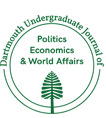Article Title
Abstract
The decision to declare a district for a specific cause is a critical policy decision; making an area an official office park or designated cultural site means it will attract specific types of residents and businesses and require specific amenities. This paper reviews the impact of designating a cultural district as a place-based policy, specifically by developing a measure of neighborhood stability and applying a stress test of neighborhood stability in cultural districts during the Great Recession. The model underpining the neighborhood stability measure is an optimal stopping time model which frames neighborhood rents as a Brownian motion with drift. This structure imposes minimalist assumptions and develops two reduced form parameters which describe individual preferences for how long to live in a neighborhood. This analysis is in the style of \cite{alvarez2015nonparametric}. The parameters are then used to test neighborhood stability, with the result that neighborhoods designated specifically as cultural districts are far less likely to experience negative stability (e.g., large amounts of residential out-migration and thus shorter residency spells) with a causal effect size four times larger than the effect size of a recession itself. However, such neighborhoods are also more likely to experience an influx of newer higher income residents after designation, implying the beneficiaries of the new stability may be those who priced out the original creators of the neighborhood's cultural capital.
Recommended Citation
Mishra, Prakash
(2022)
"The Cost of the Culturati: Studying the Neighborhood Stability Impact of Cultural District Designations,"
Dartmouth Undergraduate Journal of Politics, Economics and World Affairs: Vol. 1:
Iss.
2, Article 9.
Available at:
https://digitalcommons.dartmouth.edu/dujpew/vol1/iss2/9
Included in
Economics Commons, Education Commons, Geography Commons, Law Commons, Legal Studies Commons, Medicine and Health Sciences Commons, Political Science Commons, Public Affairs, Public Policy and Public Administration Commons

